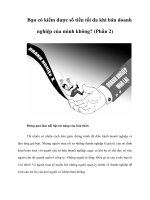Foundations of Technical Analysis phần 2 pdf
Bạn đang xem bản rút gọn của tài liệu. Xem và tải ngay bản đầy đủ của tài liệu tại đây (3.24 MB, 10 trang )
Another promising direction for future research is to consider alternatives
to kernel regression. Although kernel regression is useful for its simplicity
and intuitive appeal, kernel estimators suffer from a number of well-known
deficiencies, for instance, boundary bias, lack of local variability in the de-
gree of smoothing, and so on. A popular alternative that overcomes these
particular deficiencies is local polynomial regression in which local averag-
ing of polynomials is performed to obtain an estimator of m~x!.
6
Such alter-
natives may yield important improvements in the pattern-recognition
algorithm described in Section II.
II. Automating Technical Analysis
Armed with a mathematical representation [m~{! of $P
t
% with which geo-
metric properties can be characterized in an objective manner, we can now
construct an algorithm for automating the detection of technical patterns.
Specifically, our algorithm contains three steps:
1. Define each technical pattern in terms of its geometric properties, for
example, local extrema ~maxima and minima!.
2. Construct a kernel estimator [m~{! of a given time series of prices so
that its extrema can be determined numerically.
3. Analyze [m~{! for occurrences of each technical pattern.
The last two steps are rather straightforward applications of kernel regres-
sion. The first step is likely to be the most controversial because it is here
that the skills and judgment of a professional technical analyst come into
play. Although we will argue in Section II.A that most technical indicators
can be characterized by specific sequences of local extrema, technical ana-
lysts may argue that these are poor approximations to the kinds of patterns
that trained human analysts can identify.
While pattern-recognition techniques have been successful in automating
a number of tasks previously considered to be uniquely human endeavors—
fingerprint identification, handwriting analysis, face recognition, and so on—
nevertheless it is possible that no algorithm can completely capture the skills
of an experienced technical analyst. We acknowledge that any automated
procedure for pattern recognition may miss some of the more subtle nuances
that human cognition is capable of discerning, but whether an algorithm is
a poor approximation to human judgment can only be determined by inves-
tigating the approximation errors empirically. As long as an algorithm can
provide a reasonable approximation to some of the cognitive abilities of a
human analyst, we can use such an algorithm to investigate the empirical
performance of those aspects of technical analysis for which the algorithm is
a good approximation. Moreover, if technical analysis is an art form that can
6
See Simonoff ~1996! for a discussion of the problems with kernel estimators and alterna-
tives such as local polynomial regression.
Foundations of Technical Analysis 1715
be taught, then surely its basic precepts can be quantified and automated to
some degree. And as increasingly sophisticated pattern-recognition tech-
niques are developed, a larger fraction of the art will become a science.
More important, from a practical perspective, there may be significant
benefits to developing an algorithmic approach to technical analysis because
of the leverage that technology can provide. As with many other successful
technologies, the automation of technical pattern recognition may not re-
place the skills of a technical analyst but can amplify them considerably.
In Section II.A, we propose definitions of 10 technical patterns based on
their extrema. In Section II.B, we describe a specific algorithm to identify
technical patterns based on the local extrema of price series using kernel
regression estimators, and we provide specific examples of the algorithm at
work in Section II.C.
A. Definitions of Technical Patterns
We focus on five pairs of technical patterns that are among the most popular
patterns of traditional technical analysis ~see, e.g., Edwards and Magee ~1966,
Chaps. VII–X!!: head-and-shoulders ~HS! and inverse head-and-shoulders ~IHS!,
broadening tops ~BTOP! and bottoms ~BBOT!, triangle tops ~TTOP! and bot-
toms ~TBOT!, rectangle tops ~RTOP! and bottoms ~RBOT!, and double tops
~DTOP! and bottoms ~DBOT!. There are many other technical indicators that
may be easier to detect algorithmically—moving averages, support and resis-
tance levels, and oscillators, for example—but because we wish to illustrate
the power of smoothing techniques in automating technical analysis, we focus
on precisely those patterns that are most difficult to quantify analytically.
Consider the systematic component m~{! of a price history $P
t
% and sup-
pose we have identified n local extrema, that is, the local maxima and
minima, of $P
t
%. Denote by E
1
, E
2
, ,E
n
the n extrema and t
1
*
, t
2
*
, ,t
n
*
the
dates on which these extrema occur. Then we have the following definitions.
Definition 1 (Head-and-Shoulders) Head-and-shoulders ~HS! and in-
verted head-and-shoulders ~IHS! patterns are characterized by a sequence of
five consecutive local extrema E
1
, ,E
5
such that
HS [
Ά
E
1
is a maximum
E
3
Ͼ E
1
, E
3
Ͼ E
5
E
1
and E
5
are within 1.5 percent of their average
E
2
and E
4
are within 1.5 percent of their average,
IHS [
Ά
E
1
is a minimum
E
3
Ͻ E
1
, E
3
Ͻ E
5
E
1
and E
5
are within 1.5 percent of their average
E
2
and E
4
are within 1.5 percent of their average.
1716 The Journal of Finance
Observe that only five consecutive extrema are required to identify a head-
and-shoulders pattern. This follows from the formalization of the geometry
of a head-and-shoulders pattern: three peaks, with the middle peak higher
than the other two. Because consecutive extrema must alternate between
maxima and minima for smooth functions,
7
the three-peaks pattern corre-
sponds to a sequence of five local extrema: maximum, minimum, highest
maximum, minimum, and maximum. The inverse head-and-shoulders is sim-
ply the mirror image of the head-and-shoulders, with the initial local ex-
trema a minimum.
Because broadening, rectangle, and triangle patterns can begin on either
a local maximum or minimum, we allow for both of these possibilities in our
definitions by distinguishing between broadening tops and bottoms.
Definition 2 (Broadening) Broadening tops ~BTOP! and bottoms ~BBOT!
are characterized by a sequence of five consecutive local extrema E
1
, ,E
5
such that
BTOP [
Ά
E
1
is a maximum
E
1
Ͻ E
3
Ͻ E
5
E
2
Ͼ E
4
, BBOT [
Ά
E
1
is a minimum
E
1
Ͼ E
3
Ͼ E
5
E
2
Ͻ E
4
.
Definitions for triangle and rectangle patterns follow naturally.
Definition 3 (Triangle) Triangle tops ~TTOP! and bottoms ~TBOT! are char-
acterized by a sequence of five consecutive local extrema E
1
, ,E
5
such that
TTOP [
Ά
E
1
is a maximum
E
1
Ͼ E
3
Ͼ E
5
E
2
Ͻ E
4
, TBOT [
Ά
E
1
is a minimum
E
1
Ͻ E
3
Ͻ E
5
E
2
Ͼ E
4
.
Definition 4 (Rectangle) Rectangle tops ~RTOP! and bottoms ~RBOT! are
characterized by a sequence of five consecutive local extrema E
1
, ,E
5
such
that
RTOP [
Ά
E
1
is a maximum
tops are within 0.75 percent of their average
bottoms are within 0.75 percent of their average
lowest top Ͼ highest bottom,
7
After all, for two consecutive maxima to be local maxima, there must be a local minimum
in between and vice versa for two consecutive minima.
Foundations of Technical Analysis 1717
RBOT [
Ά
E
1
is a minimum
tops are within 0.75 percent of their average
bottoms are within 0.75 percent of their average
lowest top Ͼ highest bottom.
The definition for double tops and bottoms is slightly more involved. Con-
sider first the double top. Starting at a local maximum E
1
, we locate the
highest local maximum E
a
occurring after E
1
in the set of all local extrema
in the sample. We require that the two tops, E
1
and E
a
, be within 1.5 percent
of their average. Finally, following Edwards and Magee ~1966!, we require
that the two tops occur at least a month, or 22 trading days, apart. There-
fore, we have the following definition.
Definition 5 (Double Top and Bottom) Double tops ~DTOP! and bottoms
~DBOT! are characterized by an initial local extremum E
1
and subsequent
local extrema E
a
and E
b
such that
E
a
[ sup$P
t
k
*
: t
k
*
Ͼ t
1
*
, k ϭ 2, ,n%
E
b
[ inf $P
t
k
*
: t
k
*
Ͼ t
1
*
, k ϭ 2, ,n%
and
DTOP [
Ά
E
1
is a maximum
E
1
and E
a
are within 1.5 percent of their average
t
a
*
Ϫ t
1
*
Ͼ 22
DBOT [
Ά
E
1
is a minimum
E
1
and E
b
are within 1.5 percent of their average
t
a
*
Ϫ t
1
*
Ͼ 22
B. The Identification Algorithm
Our algorithm begins with a sample of prices $P
1
, ,P
T
% for which we fit
kernel regressions, one for each subsample or window from t to t ϩ l ϩ d Ϫ 1,
where t varies from 1 to T Ϫ l Ϫ d ϩ 1, and l and d are fixed parameters
whose purpose is explained below. In the empirical analysis of Section III,
we set l ϭ 35 and d ϭ 3; hence each window consists of 38 trading days.
The motivation for fitting kernel regressions to rolling windows of data is
to narrow our focus to patterns that are completed within the span of the
window—l ϩ d trading days in our case. If we fit a single kernel regression
to the entire dataset, many patterns of various durations may emerge, and
without imposing some additional structure on the nature of the patterns, it
1718 The Journal of Finance
is virtually impossible to distinguish signal from noise in this case. There-
fore, our algorithm fixes the length of the window at l ϩ d, but kernel re-
gressions are estimated on a rolling basis and we search for patterns in each
window.
Of course, for any fixed window, we can only find patterns that are com-
pleted within l ϩ d trading days. Without further structure on the system-
atic component of prices m~{!, this is a restriction that any empirical analysis
must contend with.
8
We choose a shorter window length of l ϭ 35 trading
days to focus on short-horizon patterns that may be more relevant for active
equity traders, and we leave the analysis of longer-horizon patterns to fu-
ture research.
The parameter d controls for the fact that in practice we do not observe a
realization of a given pattern as soon as it has completed. Instead, we as-
sume that there may be a lag between the pattern completion and the time
of pattern detection. To account for this lag, we require that the final extre-
mum that completes a pattern occurs on day t ϩ l Ϫ 1; hence d is the number
of days following the completion of a pattern that must pass before the pat-
tern is detected. This will become more important in Section III when we
compute conditional returns, conditioned on the realization of each pattern.
In particular, we compute postpattern returns starting from the end of trad-
ing day t ϩ l ϩ d, that is, one day after the pattern has completed. For
example, if we determine that a head-and-shoulder pattern has completed
on day t ϩ l Ϫ 1 ~having used prices from time t through time t ϩ l ϩ d Ϫ 1!,
we compute the conditional one-day gross return as Z
1
[ Y
tϩlϩdϩ1
0Y
tϩlϩd
.
Hence we do not use any forward information in computing returns condi-
tional on pattern completion. In other words, the lag d ensures that we are
computing our conditional returns completely out-of-sample and without any
“look-ahead” bias.
Within each window, we estimate a kernel regression using the prices in
that window, hence:
[m
h
~t! ϭ
(
sϭt
tϩlϩdϪ1
K
h
~t Ϫ s!P
s
(
sϭt
tϩlϩdϪ1
K
h
~t Ϫ s!
, t ϭ 1, ,TϪ lϪ d ϩ 1, ~14!
where K
h
~z! is given in equation ~10! and h is the bandwidth parameter ~see
Sec. II.C!. It is clear that [m
h
~t! is a differentiable function of t.
Once the function [m
h
~t! has been computed, its local extrema can be readily
identified by finding times t such that Sgn
~
[m
h
'
~t!
!
ϭϪSgn
~
[m
h
'
~t ϩ 1!
!
, where
[m
h
'
denotes the derivative of [m
h
with respect to t and Sgn~{! is the signum
function. If the signs of [m
h
'
~t! and [m
h
'
~tϩ 1! are ϩ1 and Ϫ1, respectively, then
8
If we are willing to place additional restrictions on m~{!, for example, linearity, we can
obtain considerably more accurate inferences even for partially completed patterns in any fixed
window.
Foundations of Technical Analysis 1719
we have found a local maximum, and if they are Ϫ1 and ϩ1, respectively, then
we have found a local minimum. Once such a time t has been identified, we
proceed to identify a maximum or minimum in the original price series $P
t
% in
the range @t Ϫ 1, t ϩ 1# , and the extrema in the original price series are used
to determine whether or not a pattern has occurred according to the defini-
tions of Section II.A.
If [m
h
'
~t! ϭ 0 for a given t, which occurs if closing prices stay the same for
several consecutive days, we need to check whether the price we have found
is a local minimum or maximum. We look for the date s such that s ϭ inf $s Ͼ
t : [m
h
'
~s! 0%. We then apply the same method as discussed above, except
here we compare Sgn
~
[m
h
'
~t Ϫ 1!
!
and Sgn
~
[m
h
'
~s!
!
.
One useful consequence of this algorithm is that the series of extrema that
it identifies contains alternating minima and maxima. That is, if the kth
extremum is a maximum, then it is always the case that the ~k ϩ 1!th ex-
tremum is a minimum and vice versa.
An important advantage of using this kernel regression approach to iden-
tify patterns is the fact that it ignores extrema that are “too local.” For exam-
ple, a simpler alternative is to identify local extrema from the raw price data
directly, that is, identify a price P
t
as a local maximum if P
tϪ1
Ͻ P
t
and P
t
Ͼ P
tϩ1
and vice versa for a local minimum. The problem with this approach is that it
identifies too many extrema and also yields patterns that are not visually con-
sistent with the kind of patterns that technical analysts find compelling.
Once we have identified all of the local extrema in the window @t, t ϩ l ϩ
d Ϫ 1#, we can proceed to check for the presence of the various technical
patterns using the definitions of Section II.A. This procedure is then re-
peated for the next window @t ϩ 1, t ϩ l ϩ d # and continues until the end of
the sample is reached at the window @T Ϫ l Ϫ d ϩ 1,T #.
C. Empirical Examples
To see how our algorithm performs in practice, we apply it to the daily
returns of a single security, CTX, during the five-year period from 1992 to
1996. Figures 3–7 plot occurrences of the five pairs of patterns defined in
Section II.A that were identified by our algorithm. Note that there were no
rectangle bottoms detected for CTX during this period, so for completeness
we substituted a rectangle bottom for CDO stock that occurred during the
same period.
In each of these graphs, the solid lines are the raw prices, the dashed lines
are the kernel estimators [m
h
~{!, the circles indicate the local extrema, and
the vertical line marks date t ϩ l Ϫ 1, the day that the final extremum
occurs to complete the pattern.
Casual inspection by several professional technical analysts seems to con-
firm the ability of our automated procedure to match human judgment in
identifying the five pairs of patterns in Section II.A. Of course, this is merely
anecdotal evidence and not meant to be conclusive—we provide these fig-
ures simply to illustrate the output of a technical pattern-recognition algo-
rithm based on kernel regression.
1720 The Journal of Finance
(a) Head-and-Shoulders
(b) Inverse Head-and-Shoulders
Figure 3. Head-and-shoulders and inverse head-and-shoulders.
Foundations of Technical Analysis 1721
(a) Broadening Top
(b) Broadening Bottom
Figure 4. Broadening tops and bottoms.
1722 The Journal of Finance
(a) Triangle Top
(b) Triangle Bottom
Figure 5. Triangle tops and bottoms.
Foundations of Technical Analysis 1723
(a) Rectangle Top
(b) Rectangle Bottom
Figure 6. Rectangle tops and bottoms.
1724 The Journal of Finance









